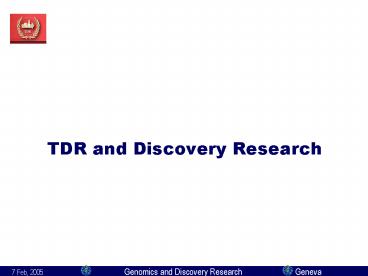TDR and Discovery Research - PowerPoint PPT Presentation
1 / 37
Title:
TDR and Discovery Research
Description:
To undertake research, development and evaluation of new and ... e.g. IAVI, MMV, TBAlliance, Microbicide In., FIND. Broad based, multilateral, intergovernmental ... – PowerPoint PPT presentation
Number of Views:60
Avg rating:3.0/5.0
Title: TDR and Discovery Research
1
TDR and Discovery Research
2
TDR Mission
- To undertake research, development and evaluation
of new and improved tools and interventions to
fight major tropical diseases - To strengthen research capabilities in countries
where these diseases are endemic
3
Leading causes of deathGlobal (2002 data WHR
2004)
Respiratory
digestive
Maternal
Other
10
5
Injuries
7
12
Infectious
Cancers
diseases
13
26
Cardiovascular
27
Infectious Diseases accounts fro 45 deaths in
low income countries
4
Diseases of Resource Poor Settings Diseases of
Neglected Populations
5
Leading causes of deathAfrica (2002 data WHR
2004)
Infectious
diseases
64
Infectious Disease Burden by DALY's 60
6
Concept of Use-Inspired Research
Considerations of use?
No
Yes
?
Pure basic
Use
-
inspired
research
research
understanding
Yes
Yes
Industry, Public Institutes
Academia
TDR, HRP, IVR, AHPSR
PPP's etc.
fundamental
Pure applied
research
No
No
for
Disease control
Quest
No
Yes
7
Concept of Use-Inspired Research
8
Research Pathway
9
Look beyond single issuesManaging Interfaces
10
Look beyond single issuesCross-cutting activities
11
Modified TDR Structure
Research Capacity Building
Implementation Research and Methods
Strategic Discovery Research
Product Devt. and Evaluation
Science Strategy and Knowledge
12
Three disease categories need different RD
strategies
New Basic Knowledge
New and Improved Tools
New and Improved Strategies
New and Improved Methods
Category II
Category III
Category I
13
Three disease categories need different RD
strategies
New Basic Knowledge
New and Improved Tools
New and Improved Strategies
New and Improved Methods
Category IIChagas FilariasisLeprosy Malaria Onc
hocerciasis
Category III
Category IAfr. TrypsLeishmania Schistosomiasis
1975
14
Three disease categories need different RD
strategies
New Basic Knowledge
New and Improved Tools
New and Improved Strategies
New and Improved Methods
Category IIIChagas diseaseFilariasisLeprosyOnc
hocerciasis
Category IAfr. TrypsDengueLeishmania
Category IIMalariaSchistosomiasisTuberculosis
2000
15
Three disease categories need different RD
strategies
New Basic Knowledge
New and Improved Tools
New and Improved Strategies
New and Improved Methods
Category IIIChagas diseaseFilariasisLeprosy Mal
aria?Onchocerciasis Schistosomiasis?
Category IAfr. Tryps ? ?
Category IIDengue? Leishmania? Tuberculosis ?
2015?
16
Reasons for Progress
- Enhanced scientific activity
- New tools, methods and strategies
- Capacity, especially in developing countries
- Increased ownership by countries of policy
- Increased research capacity
17
The story of Onchocerciasis
- Ivermectin identified effective against
filariases in lab. - TDR worked with Merck to develop for
onchocerciasis - Registered in 1987 by FDA
- Mectizan donation by Merck
- Initiation of control programme based on annual
treatment - Research develops and validates Community
directed methods
18
Onchocerciasis Control Accomplishments
- 40 million people protected from onchocerciasis
- Onchocerciasis no longer a problem of public
health importance/ obstacle to socioeconomic
development - 12 million children born since 1974 have grown up
without risk of disease and blindness - 25 million hectares of fertile riverside land
re-settled with agricultural production
sufficient to feed 17 million people each year - BUT WE STILL NEED A MACROFILARICIDE!!
19
MSF (2001) Fatal Imbalance The Crisis in
Research and Development for Drugs for Neglected
Diseases Yamey (2002)The world's most neglected
diseases. Br.Med.J. 325176-177
20
Much of progress due to new drugs(over half
managed in partnership with TDR)
21
Recent regulatory successes
- Miltefosine 2002
- Lapdap 2003
- Label extension for Coartem to 5 kg 2004
22
Previous Discovery Successes
- Ivermectin for onchocerciasis and lymphatic
filariasis (1972) - Eflornithine for African trypanosomiasis (1982)
- Miltefosine for leishmaniasis (1993)
- Moxidectin for onchocerciasis (1999)
- Two antimalarial peroxide leads passed to MMV
(2000) - Bisamidine class now supported by Gates for HAT
(1999) - Natural Product manzamine for malaria (2002)
- Others (including some that did not make it to
devt.)
23
Many New Significant (PPP) activities (source
Giorgio Rossigno- FIND)
24
Types of Organisation
- National Agencies (both for science and
development) - Strategic 'innovation' funding
- Gates, Grand Challenges
- Research specific consortia
- Gates sponsored, EC sponsored, NIH sponsored
- Single issue (portfolio-based) not for profit
foundations - e.g. IAVI, MMV, TBAlliance, Microbicide In., FIND
- Broad based, multilateral, intergovernmental
- Owned by governments, owned by public
- i.e. TDR
25
Priority Setting
26
Strategy ??
DEFINES PRODUCT PROFILES
27
Look beyond single issuesManaging Interfaces
28
The Post Genomic Challenge
Sequencing bacterial and parasitic pathogens...
could buy the sequence of every virulence
determinant, every protein antigen and every drug
target for all time. B.R. Bloom (1995) Nature
378, 236
29
RD Process Funnel
NIH, Wellcome Trust, MRC, EC, etc.
30
Target Discovery Validation
Metabolites Macromolecules
DNA
RNA
Protein
Genome
Proteome
Metabolome
Transcriptome
Comparative database mining
Comparative biochemistry molecular biology
Chemical screens
Potential targets
Genetic validation (essentiality)
Chemical validation (selectivity/druggability)
Validated targets
(added value)
31
Discovery as part of product RD process
NIH, Wellcome Trust, EC, etc.
Discovery
32
The Drug Discovery Process
A role for Natural Products
33
Drug Discovery for Tropical Diseases Requires
Partnership
Public health organizations
Academia
Biopharma industry
Partnerships
34
WHO/TDR Drug DiscoverySome of our Biopharma
Partners
35
TDR Compound Testing
Database with monthly review and monitoring of
data
SLEEPING SICKNESS
MALARIA
SCHISTOSOMIASIS
LEISHMANIASIS
CHAGAS DISEASE
Standard operating procedures and comparative
assessments
LYMPHATIC FILARIASIS
ONCHOCERCIASIS
36
Challenges
- Top Priority is New Lead Molecules and
Diagnostic Leads across TDR diseases - Better integrate genomics and discovery
activities - Further professionalise activities e.g. thru
further link to industry (and other) HTS - Take into account natural products
- Take note of capacity building opportunities
- Recognise strengths of other organisations (MMV
etc.) - Develop and enunciate a strategy that can justify
and leverage funds
37
Public Health Impact is Final Goal































